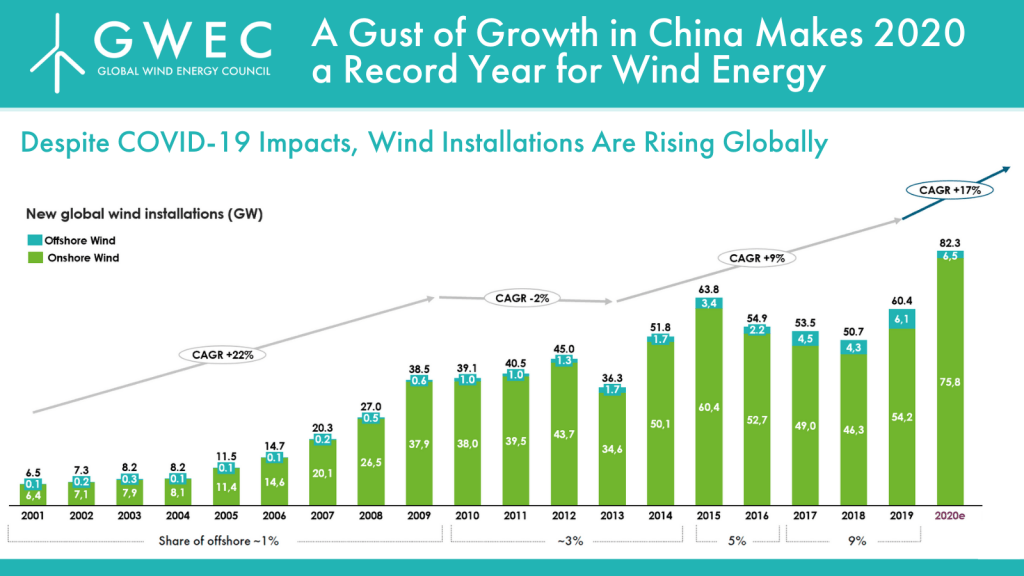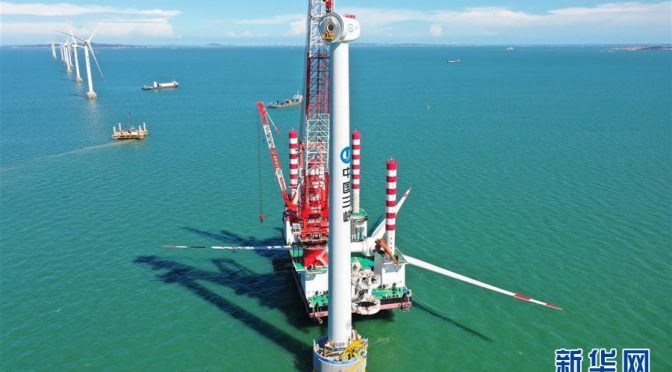The 2020 new wind power capacity figures for China, released yesterday by the National Energy Administration (NEA), are truly formidable. The NEA announced that a staggering 71.7 GW of new wind capacity was installed last year – more than double China’s previous annual growth record and far exceeding GWEC’s Q3 2020 expectations.
Ben Backwell, CEO at GWEC commented: “Wind companies and industry-watchers have been reacting to these figures with a combination of surprise and awe. Ten years ago, when annual global wind installations of wind totalled just 39 GW in 2010, it would have been unfathomable to see this volume contributed by a single market. Yet, China’s wind installations figures are yet another testament to the resilience of the wind energy sector amid COVID-19, as well as the growth possibilities when scale and policy commitment are jointly applied”.
It should be noted that the 71.7 GW figure represents the total grid-connected capacity in China in 2020, and not necessarily the year in which wind turbines were installed. The Chinese Wind Energy Association (CWEA), a GWEC member, estimates that 26.3 GW of the wind power installed by the end of 2019 was actually grid connected in 2020, and this capacity was thus included in the NEA’s 2020 figures. Excluding this latent volume, the new grid connected wind power capacity for 2020 in China would total 45.4 GW.
Ten years ago, when annual global wind installations of wind totalled just 39 GW in 2010, it would have been unfathomable to see this volume contributed by a single market. Yet, China’s wind installations figures are yet another testament to the resilience of the wind energy sector amid COVID-19, as well as the growth possibilities when scale and policy commitment are jointly applied Ben Backwell, CEO, GWEC Tweet
45.5 GW is still a monumental achievement – nearly equivalent to the entire global capacity installed in 2018 – and would still be a record year for the Chinese wind market. The surge in installations exceeds GWEC’s Q3 2020 forecast for China by 11 GW, and makes 2020 a record year of wind growth with an estimated 82.3 GW of new wind power capacity globally, according to initial calculations by GWEC, which represents a 36% year-on-year increase in installations. According to GWEC Market Intelligence, theglobal wind industry is now on-track to go from strength to strength and weexpect to see similar installation levels in 2021.

The installation rush in China was largely expected, due to the phase-out of the onshore wind Feed-in-Tariff scheme by the end of 2020. However, this level of growth goes above and beyond even the most optimistic forecasts. A rapid bounce-back from the initial impacts of COVID-19 allowed installations to proceed last year. China is the only major economy to reflect economic growth during the pandemic: Official figures report 2.3% GDP growth in 2020 and domestic electricity demand exceeded 2019 figures from April 2020 onward.
Qin Haiyan, Secretary General at CWEA, added: “Although the COVID-19 pandemic impacted China’s wind industry early on in 2020, the Chinese government took prompt and strong measures to effectively contain the virus. This allowed the sector to resume ‘business as usual’ manufacturing and installation activities as early as March 2020, which was crucial for the sector to complete projects with the looming subsidy deadline. In order to help smooth the way forward and play their part in helping to achieve China’s net zero target, grid companies also took various measures to overcome bottlenecks and connect as many projects as possible before the end of 2020”.
These figures cement China’s position as a juggernaut in the wind industry, and with its offshore wind Feed-in Tariff due to expire by the end of 2021, we are set for another strong gust of growth in the Chinese offshore wind sector this year. According to the Beijing Declaration, signed by over 400 wind power companies at the end of 2020, China needs to install more than 50 GW of new wind power capacity annually from 2021-2025, and more than 60 GW annually from 2026 onwards, in order to reach its carbon neutrality target by 2060. China’s surge of wind power capacity in 2020, even in the face of a global pandemic, clearly shows that this level of wind power deployment is possible.
Although the COVID-19 pandemic impacted China’s wind industry early on in 2020, the Chinese government took prompt and strong measures to effectively contain the virus. This allowed the sector to resume ‘business as usual’ manufacturing and installation activities as early as March 2020, which was crucial for the sector to complete projects with the looming subsidy deadline. Qin Haiyan, Secretary General, CWEA Tweet
As the initial shock from China’s 2020 figures fades, the industry must recognise that this ramp-up in installations must be called for across global markets to adequately address the climate emergency. Wind power offers the greatest carbon mitigation potential per MW of all renewable energy technologies, and will be key to achieving national decarbonisation commitments and international targets, like the UN’s net-zero by 2050 goal. It is clearer than ever that the industry has the capacity to deploy more wind power capacity, affordably, rapidly, and exceeding all expectations of business as usual.
GWEC will release its official 2020 wind power figures and address China’s market growth and wind energy’s role on the global road to net zero in GWEC’s Global Wind Report 2020, due to be published in March 2021.


